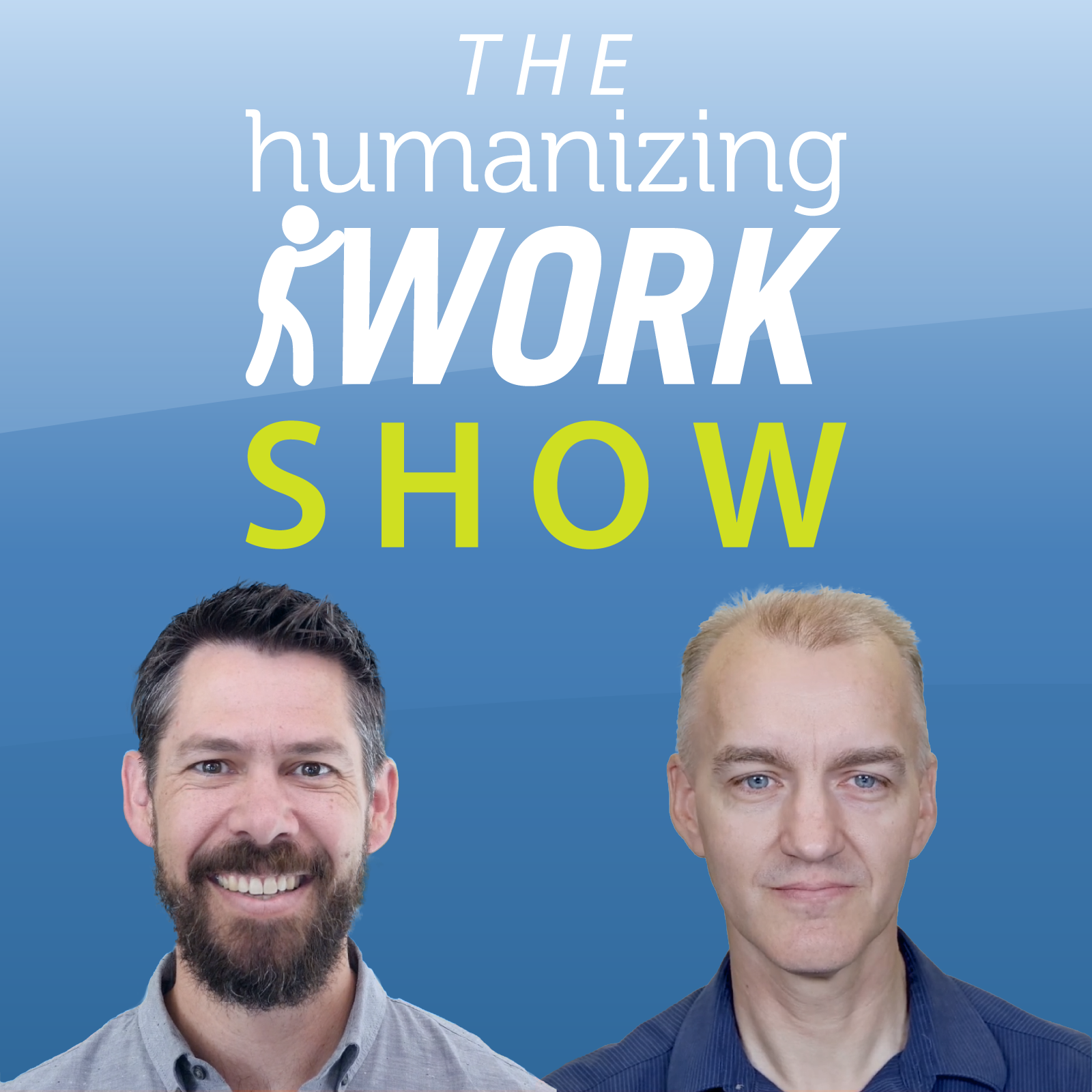Episode Transcript
Peter Green: Welcome to the Humanizing Work Show. This week I was catching up with one of our favorite clients, just a lovely person, who we hadn't spoken to in a few months. And she was catching me up, telling me how she was working on a few various projects, and then she told me that she was tired of trying to make a culture that was engaging and exciting.
I said, oh, no, she's burned out! And she said, "I'm not burned out, i'm just focused now on making a culture that's calm and supportive. No more focus on kombucha in the fridge and ping pong tables and parties at the bowling alley. I just want my people to experience good, purposeful work without unneeded stress."
This struck me as a very wise stance on culture. So today, Richard and I are gonna share a few thoughts on why this might be a good idea for most of our clients, to focus on this type of culture, how leaders might mess up that goal of creating that kind of culture, and then a few specific things you could do to successfully create that kind of culture on a team.
Richard Lawrence: All right, Peter. I kind of get what she meant, but an objection immediately comes to mind for me. When you talk about a calm, supportive culture, I can totally see a leader saying, "we have important things to do around here! We've got real deadlines! We're not paying people to come to a meditation retreat at work. Calm's not what we're doing." How do you answer that? How do you clarify what you mean by calm and supportive?
Peter: You're channeling some tech bro leaders there, Richard.
Richard: You're gonna get replaced by AI if you get too calm.
Peter: Well, I think that even if you look at the most successful tech companies, right, where some of that ethos can come from, what do the actual makers from those companies do?
Well, they try and get into flow states because that's where they're most productive. And we know that when you're in flow, you feel calm.
And there are specific precursors to that, right? In order to get that level of focus, to be into what Csikzentmihalyi calls a flow state, the work has to be challenging but doable. So it's kind of on this boundary between, "yeah, I have the skills to do it. But it's still hard." That's what keeps me engaged. And importantly, the work matters.
When we have those characteristics, that's what people call being in the zone. So that's where the best work of all humans gets done is when we're in that flow state.
And, anything that's gonna interrupt that is gonna break the sense of flow. And so I like this idea of a calm and supportive culture that enables people getting into flow states, because if, to put it in just very sort of capitalist terms, that's the most productive type of culture you could have.
Richard: It sounds like focus is really key there, 'cause stressful cultures often have interruptions and imposed urgency. And sometimes stressful cultures don't even have interruptions because people are jumping in and changing priorities, but because their structures are set up in such a way that you can't focus on something and get it done.
We often see this with just bad team structures, where it takes a bunch of different teams in order to get something meaningful done. You can't focus and accomplish something because you're constantly managing dependencies.
Peter: Mm-hmm. Right. Yeah. I think that's a good example. And the other thing that comes to mind is, as I think about, "what's the alternative type of culture?" Is, a lot of times people have a really stressful culture because they're pushing hard or because they, they haven't addressed the root causes of why people can't get into those flow states, and so they almost pay you off.
They're saying, I know it's gonna be super stressful, but there's gonna be a huge stock option. There's gonna be a huge bonus. We're gonna have these crazy fun parties. We're bringing in Dr. Dre to play at the team party on Friday. Right? Like, they almost buy your willingness to stay there like this extrinsic thing.
And for a lot of companies that works. If those rewards are high enough, to a certain extent, like, "okay, it's hard, but I'll put up with it."
What that isn't is sustainable. And it's probably not right for a diverse set of employees. That's probably good for single young people. They can put up with that, this like, kind of a fun party culture at work where everybody's making a lot of money, we're having a lot of fun together.
But that limits your options for who you can employ. I'm not gonna work in that kind of culture at 50 years old with five kids and a wife that I love. I'm just not gonna put up with it. Right? I'm not gonna put up with that level of stress.
So I think there is something about the extrinsic motivators that people can use in those stressful cultures to try to make up for it. To try to say, "yeah, I know it's hard, but we'll give you this."
Richard: It seems like that's well aligned with the funding model. That if you're doing venture capital funded work, the whole model there is that most of these are going to burn out, and a few of them are going to be really successful.
So it's that "burning hot and fast" kind of approach. And so you almost need a different kind of funding and governance if you want to create a calm. And sustainable culture.
Peter: Yeah. And this is probably a, a whole different episode, but there are models like that that are emerging in the world to try and address that.
And even for the companies that succeed at that, right, get through that VC level, fast burn. What happens next? Right? Either an IPO stage or preparing for private equity, what do they do? They quote unquote, bring in the adults to calm things down, right? Because people recognize even in that world, it's not sustainable.
That type of culture's not sustainable because we can't keep buying people off as we scale. We can't buy their energy anymore, so you have to do it intrinsically.
Now, a lot of the times when they bring in the adults, they do the opposite of what we would want here. They stifle everything and they shut everything down, and they treat everything as if it's predictable and bring in too much process. So that's not what we would recommend.
What we would recommend though, as a company at this stage, that wants things to be sustainable and scalable, is to really focus on the intrinsic motivators. Things like: "I feel competent in my role and I'm getting better at it." Right? What Dan Pink called mastery.
"I feel some sense of control in the work that I do." Like I'm not always being told to go left when I think we should go right, told how to do my job.
And most importantly, and connected to the discussion about flow, the work matters. A couple episodes ago when we were talking to Steven Puri, who was the Hollywood exec, uh, who now has his company, the Suhka, he mentioned that nobody gets into a flow state when they're making or filling out a TPS report, right? It's like the work doesn't matter.
And so make sure that the people doing the work have a real clear connection to why the work matters for somebody. And it doesn't have to be "we're gonna save the planet." It can just be, "I'm gonna make life a little bit easier for this other person on this other team." That's meaningful work. It's in service of somebody else.
Richard: Okay, so let's talk about how our friend, the leader at this company who wants to make things calm and supportive in her culture, could mess it up. Before we get into, how would you do this, how would you, with good intentions, totally end up ruining it. What immediately comes to mind for you, Peter?
Peter: The first thing that I thought of is she could attach extrinsic rewards in some way. I don't know how you would do this for, for calm and purposeful, but it would be people being incented to, not to do more than X, right? Like work within yourself. And so your incentive is this. And if, and your bonus is attached to that, or if you're sending emails past 5:00 PM that's a downside, right?
There are sort of rules-based versions of this. That I don't think will do the job. 'Cause what we really want to tap into here is the intrinsic motivators of people feeling supported, people feeling like their work matters, and feeling like they can do a good job at it.
One of our favorite books on this, by the way, is Punished by Rewards, by Alfie Kohn. It's just a fantastic book. If you're a parent, teacher, or manager or leader, you should have this book on your bookshelf. Probably review it every couple of years. It's just really, really good review of the literature on how most of the carrots and sticks that we put into our lives are doing the opposite of what we hope they'll do.
Richard: An interesting example of this one that comes to mind is a change between the first edition and the second edition of the Extreme Programming Explained book. In the first edition, one of the principles was 40 hour work Week. Mm-hmm. It's we wanna have this calm, energized, sustainable kind of work. And so we're not going to do overtime. We're not gonna ask people to work nights and weekends, which was a common practice in software development, especially towards the end of a project.
So we're gonna make things calm. In the second edition, 40 hour work week had been replaced by sustainable pace. And that's actually the thing that made it into the Agile Manifesto is about sustainability, because there was a realization that sometimes you're in this flow state, you're building something important, you have a real external deadline. You may end up working a little more than 40 hours. Other times you may end up working less, and measuring around the hours can lead to the wrong results.
So it was about is this sustainable? Could we keep doing this indefinitely? Could we continue delivering value at that pace? And I thought that was an interesting shift from what can we measure to something more healthy?
And so I remember telling my teams in the early 2000s, "if you have to work overtime for some reason, make it visible, and then let's talk about that decision and how we feel about it and whether it's sustainable."
So there's no rule about it exactly, but we want to work in a sustainable way. So let's make visible if we have to work more than that.
Peter: It occurs to me that the motivation for the extra work impacts whether or not it's sustainable. If it's my boss telling me, once again, I need to come in for a few hours on Saturday, that is not motivating, right? That's gonna go again against all of those intrinsic motivators, and it's probably not sustainable for me or for the organization.
On the other hand, if I'm in a flow state and I want to keep going, or the work really matters to me, and I know a customer really needs this by Friday in order to be at this trade show, or to accomplish this outcome that's time-bound, I might be self-motivated to work a few more hours and then things ebb and flow naturally that way. As long as, again, you make it visible, it's not a pattern, you have some recovery time built into that. Right? So I think the motivation matters, right?
Richard: Another way that our friend could screw this up in her organization is declare that the culture is going to calm and sustainable and still let everybody be overcommitted.
Everything is still important. We still have to accomplish everything, not actually making space for flow states and energized, but calm productivity to happen.
Peter: Mm-hmm. I'm thinking of two famous examples of CEOs deciding to cut back. One is when Steve Jobs was fired from Apple and then returned. Apple had several product lines, they were in a lot of different spaces. And Jobs just said, there's too many, we can't focus. We can have four products. Right? Two professional products, two consumer products. He gave a two by two grid. These are the four products. Everything else is cut. The goal of that was to focus and do good work on those four things.
The other one is, we've told this story on the show before, is Andy Grove at Intel in the early days of Intel saying memory chips are where we're making our money. Processors seem to be the future, but it's risky. I dunno if we have enough funds to do both. And then the famous story of them saying, if they fired us and hired a new CEO tomorrow, what would they do?
And they said, oh, we, they'd get into processors. They said, okay, let's go outside, come back in as the new CEO and let's get into processors.
The part of that story that I think is important to mention is that they could have just said, well, let's just do both. Let's split our people on both. Let's burn 'em all out, trying to do both memory and processors. No, they recognized, we can focus on doing one thing really well.
Richard: A third way to screw up, and this is probably the one that is most at risk here, I think, knowing some of the history with this organization, and that would be too much inward focus on the culture and how we're feeling and how calm it is, and taking your eye off of the meaning and purpose of the work.
Focus on how we're feeling and how sustainable it is. I picture, uh, the dude from the Big Lebowski we're just abiding. It's not about getting stuff done here. Uh, so that's a tricky thing when, when you wanna focus on culture, you can't really focus on culture directly. It's in service of something else.
Peter: This work matters. "Well, that's just like your opinion, man."
Well, I notice that that keeps coming up in this discussion. That the meaning of the work is the keystone to this. Without that keystone in place, everything else is gonna fall apart. The work has to matter.
And so the leader's job of creating clarity of what's important and why is it important, is key to any of these other cultural things. Just focusing on the culture doesn't help if it's not clear why the work matters and what we're supposed to focus on.
Richard: Right. When clients bring us in to build a healthy team, whether that's a leadership team or a product team, we don't start with "what are our working agreements? How do we wanna behave with each other?"
We start with "what is our shared purpose? Why does this team need to exist? What couldn't happen if this team didn't exist?" Now we have a reason to be a team. Then we can talk about how do we wanna be as we do this work.
Peter: I'm looking up which episode number this is Richard, but I wanna point people to our episode on Culture Signals.
Episode 71 gives the basics of this, but you wanna give us a quick reminder, what's a culture signal? And then we'll talk about an example of a culture signal this leader could potentially experiment with.
Richard: A culture signal is a strong signal a leader gives about a trade off that they care about. What are they willing to give up to get something else?
And the classic, really clear example that we give in a lot of conversations about this is Tony Hsieh at Zappos signaling that we care so much about emotional connection with our customers that we're willing to have ridiculously long and inefficient calls in our call center.
And the call centers are a space where "get the problem solved and get off the phone" is usually the highest goal.
Peter: That's efficiency. Right?
Richard: Right. That- it is efficient. And we should be careful not to say that that's all bad. When I call to get something solved, I want it solved quickly, right? I don't wanna spend hours on the phone. I want it to be solved. I also wanna get back to something else. So that's not inherently bad to be efficient at solving your customer's problems.
But Hsieh believed we don't wanna be efficient at the expense of connection with our customers. And so he sent a strong signal by celebrating ridiculously long customer service calls, like 10 and a half hours, or examples of people totally going above and beyond, sending somebody flowers when they had to return their late father's unused shoes. Things like this, that are way beyond just efficiently solving the problem.
He didn't celebrate the ones that were short and good. He celebrated the ones that were ridiculously over the top and good because that sent a really clear signal. We're willing to give up efficiency for this other thing we value.
So if you wanna send a strong culture signal about making things calm and sustainable, what would you suggest, Peter?
Peter: It's tricky because I, there are some things you could do that would just be "no more parties," right? Like no more parties just sounds like budget cutting or somebody's just being stingy, right?
And you can't just say it like the important thing about a culture signal is, it is a behavior. Where people say, oh, they really mean it. And so it has to be a behavior that makes the trade off obvious. If this leader was feeling like there's too much interruption and that's one of the root causes as she diagnosed, why, why do we need this so badly?
One thing she could do is put an out of office notification on her own email in the morning. That's not, I'm outta the office, it's, "today. I'm focused on this one single thing. If your email's related to that thing, I'll check it at lunchtime. If it's not, I'll respond to you first thing tomorrow morning." Just like we would if we were outta the office.
But it's a signal that I am focused on this one thing today, and I'm trying to get into a flow state on that.
And probably even better would be encouraging her direct reports to do the same thing. Pick your singular focus for the day. Set an outta the office notification for your email and for Slack and any other tools that you're using that says, this is what I'm focused on. Nothing else matters to me today, essentially.
So that would be an example of like, "wow, she really means it, she's behaving in accordance with what she's espousing." The integrity of that is what makes a culture signal effective.
Richard: Mm-hmm. And then that's kind of the culture signal that sets up the bigger culture signal, which is: what happens when someone powerful is upset about that?
Right? Somebody wanted to interrupt and they can't, and they're upset about it, especially if they're upset, like they complain to her about one of her directs not being responsive.
That's the moment where the real culture signal happens. Like how does she stand up for that value, even if it makes somebody important upset.
So sometimes culture signals are layered like that. You have the, the small one that sets up the more memorable one, which is kinda what happened at Zappos too. They didn't know that a long call was coming. They emphasized that the length of the call didn't matter and they stopped measuring average handle time, like most call centers would.
And then when that crazy long one tested the boundaries of it, they celebrated it rather than being like, whoa, whoa, whoa, let's scale it back here. Like 10 minutes of connection's good. 10 hours, maybe not.
Peter: Well, thanks for tuning in to this episode of the Humanizing Work Show. You can visit humanizing work.com to learn more about our workshops, our coaching, and our online resources, or to bring us in to support your team.
Our upcoming leadership intensive goes deeper on creating motivation and flow, and we study multiple examples of great culture signals from very forward thinking cultures, including the Zappos example that Richard shared in this episode. You can find more information about that in the show notes.
And if you get value from the show and you wanna support it, the best thing you can do if you're watching on YouTube is subscribe, like the episode, click the bell icon to get notified of new episodes, and drop us a comment with your thoughts on how you create culture.
Richard: If you're listening on the podcast, a five star review wherever you get your podcasts makes a huge difference in whether other people who'd benefit from the show find it or not. So thanks again for tuning into this episode, and we'll see you next time.




